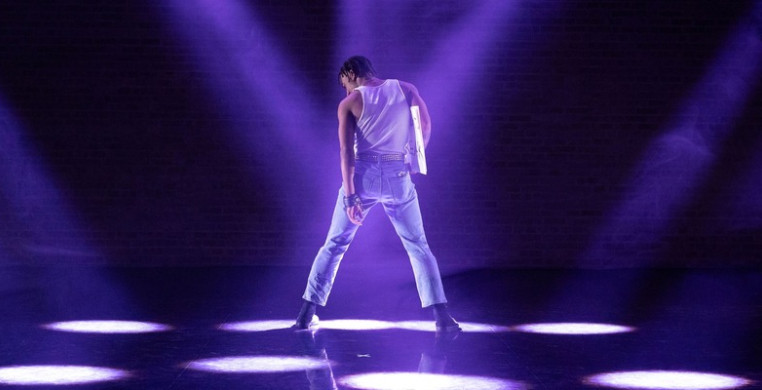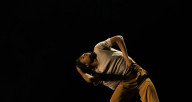The Greek philosopher Aristotle wrote, "The whole is greater than the sum of its parts,” which encapsulates the idea that when elements come together to form a collective entity, it has greater capabilities leading to something new and greater. Take, for example, a professional dance company like Visceral Dance Chicago (VDC). The dancers, each with their strengths, perspectives, and weaknesses, are joined together to embody a new entity capable of creating and performing great artistry. However, the focus on the whole can overshadow the unique abilities and styles of the individual dancers.
Oftentimes company work relies on blending the dancers’ abilities together. VDC’s “Solus” (2024) offers an opportunity for each of its company members to showcase their facilities in an evening of solo works. The event reminds us of the importance of acknowledging the individual voices of each artist, and what they contribute to the whole.
All ten company members of VDC performed solo works choreographed by Chicago dance artists: Morgan DiFonzo, Malcolm Maurice, Shannon Alvis, Kia Smith, Sayiga Eugene Peabody, Abdiel Figueroa Reyes, Hanna Bricston, Brian Josiah Martinez, Trae Turner, and Harrison McEldowney.
The diversity in the genres of movement, music, and storytelling demonstrated diversity in the VDC ensemble while showcasing the exceptional variety of dance in Chicago.
While each soloist was poised and arresting in their presentation, the evening was over in just one hour and felt abrupt, leaving the audience craving more. However, “Solus” serves as a wonderful sampler of what the individual members of VDC have to offer, and many individual performances stood out in the whirlwind of ten separate pieces.
 “Ceto," with Laura Mendes; Katie Miller Photography
“Ceto," with Laura Mendes; Katie Miller Photography
The audience was treated to a stunning performance by dancer Laura Mendes in “Ceto” choreographed by Shannon Alvis, former Hubbard Street Dance Company and Nederlands Dans Theater member. In Greek mythology, Ceto is a sea goddess, daughter of Gaia (the Earth) and Pontus (the Sea). She is often depicted as a monstrous sea creature or a serpentine sea monster and often represents chaos.
From the first scrupulous undulation of Mendes’ shoulder blades to the numerous leg extensions that ended in tempered release, the chaos inherent in the goddess of Ceto was fully embodied through the performance. The portrayal was executed with a finesse that only an artist with a fine-tuned instrument could accomplished. As limbs extended and erupted across the stage, Mendes emulated both the gentle flow of water and the violent crashing of waves. Mendes held her audience captive and truly encapsulated the divine power of Ceto.
In the second half of the bill, the mood of the evening was taken to a new height as Alessandra DePaolantonio commanded the room with Abdiel Figueroa Reyes’ work, “Veni, Vidi, Vici (I Came, I Saw, I Conquered)”. The phrase, attributed to Julius Ceasar, one of the most famous military commanders and statesmen in history, has become a popular and widely recognized expression of triumph and victory. It is with that distinct energy that DePaolantonio moved across the stage, demanding conquest over the space around her.
 “Veni, Vidi, Vici," with Alessandra DePaolantonio; Katie Miller Photography
“Veni, Vidi, Vici," with Alessandra DePaolantonio; Katie Miller Photography
Reyes utilized DePaolantonio’s athletic boldness requiring her body to move through strenuous phrases, including quick footwork, argumentative arm gestures, and strained facial expressions. Who or what DePaolantonio is at war with is unknown, but through various vignettes, framed by moments of darkness in which the performer changes her appearance and position onstage, it is clear that she was meant for this path of war and will follow it to fruition.
The penultimate performance, “Amo,” was choreographed by Trae Turner and danced by Kaliana Medlock. Percussive drum beats filled the theater, an instant joy spreading through the room as Medlock began to move to the rhythmic beats in both contemporary dance and street dance styles. The solo was truly a duet between Medlock and the music as isolations through her chest, arms, hips, and shoulders accentuated and highlighted the rhythms blasting through the speakers.
 “Amo," with Kaliana Medlock; Katie Miller Photography
“Amo," with Kaliana Medlock; Katie Miller Photography
“Amo” was not a dance highlighting technical feats, such as extended balances on one leg, explosive jumps, or multiple pirouettes. What was shared through the choreography and its execution was the connection of the human spirit to music, and how that channels itself into a dance that we can all feel deep in our bones. As we witness Medlock’s joyful migration throughout the space, the audience becomes lively in their seats, bodies bopping side to side, with audible hollers as Medlock sinks into familiar grooves.
The evening concluded with “Break Under Pressure,” by Chicago dance legend Harrison McEldowney, and danced superbly by Tyson Ford and a generous volunteer from the audience. McEldowney, known for his choreographic comedic wit, did not disappoint as the work stirred up laughter and smiles at the end of a night of serious works.
Ford, dressed in a white tank top and blue jean combo a la Freddie Mercury, dances out from the wings holding large white poster boards (think “Love Actually”), each with a different proverbial message regarding human nature and the acceptance of being broken. The last card asks for an audience volunteer, and Ford pulls up an energetic participant on stage, handcuffing himself to his new dance partner. Ford carries on dancing to a mashup of 1980s hits including “Under Pressure,” “I Want To Break Free,” and “Black Or White,” while trying to break away from the restraints binding the two performers together.
While not ground-breaking in its composition, the performance was a beautiful reminder that dance is not about the perfect lines, the most innovative choreography, or having a sold-out show. Dance is about the joy that we feel and the connection that we create with one another while viewing it, creating it, or participating in it.
While “Solus” does not serve as a fulfilling evening of concert dance, it offers a glimpse into the artistry and talent of the dancers within the Visceral Dance Chicago company. The evening serves as a reminder that while the whole may be greater than the sum of its parts, it does not hurt to take a step back and acknowledge the beauty of those individual components that together create such a remarkable whole.
For more information about Visceral Dance Chicago, click the company link below.




